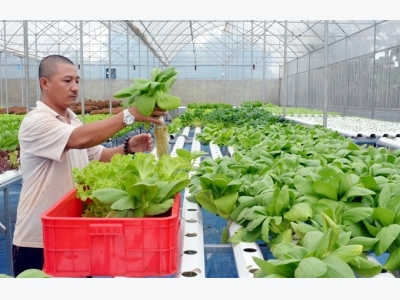High-tech farming development sluggish

A farmer is harvesting hydroponic vegetables grown in a hothouse in Buôn Ma Thuột City in the Central Highlands province of Đắk Lắk. — VNA/VNS Photo Tuấn Anh
HÀ NỘI — The development of high-tech agriculture in Việt Nam remains sluggish due to unplanned and small-scale production, and is not commensurate with the country’s comparative advantages and efforts.
So far, only 28 enterprises nationwide have been recognised by the Ministry of Agriculture and Rural Development (MARD) as high-tech businesses.
At a conference held yesterday by the (MARD) in the Central Highlands province of Lâm Đồng’s Đà Lạt City, participants agreed that development of technology-based agriculture is essential for Việt Nam’s agriculture sector to achieve greater value-added for export products, global competitiveness and consistently high quality.
Speaking at the event, Deputy Minister of Agriculture and Rural Development Lê Quốc Doanh said over the past three decades of renovation, Việt Nam has become self-sufficient in food with an annual export of US$30 billion, providing livelihoods for 10 million rural households and contributing nearly 22 per cent of the gross domestic product and 23-35 per cent of exports. However, the agricultural sector tends to grow slowly due to spontaneous and small-scale production, limited technological application in agro-forestry-fisheries enterprises, and impacts of climate change, environmental pollution and food hygiene, he said.
The Government has adopted various policies to promote the development of high-tech agriculture. In 2012, for example, the Prime Minister issued Decision 1895 approving implementation of an agricultural development programme using high-tech applications.
The programme aims to promote the development and effective application of high technology in the agricultural sector, contributing to the development of a large-scale, modern, and highly competitive and comprehensive agriculture model.
It also targets an annual growth rate of over 3.5 per cent in the agricultural sector while ensuring national food security.
In 2015, the PM signed another decision approving the master plan to build 10 high-tech agricultural zones by 2020.
But in fact, by mid-2017, the whole country has only two high-tech agriculture zones, established in the southern provinces of Hậu Giang and Phú Yên.
During the conference, participants hailed Lâm Đồng Province for being on the way to becoming a model of high-tech farming.
The province has tremendous potential to attract more foreign investment in high-tech agriculture due to its climate, land and proximity to the southern economic region.
By applying technology in cultivation, the average value of hydroponic vegetables grown in the province has reached VNĐ500 million per hectare per year, and the value of flowers touches VNĐ1.2 billion per hectare per year. The figures for tea and coffee are respectively VNĐ250 million and 240 million per hectare per year.
Many farm produce of the province have been exported.
However, according to Nguyễn Văn Sơn, director of the provincial Department of Agriculture and Rural Development, farmers and businesses engaged in high-tech agriculture in the province still face many difficulties relating to land funds, shortage of investment, and access to investment capital.
A representative from the Ministry of Natural Resources and Environment’s General Department of Land Management underscored the need to refine regulations on the rights of land users and issue policies to encourage the rent of land use rights.
According to the State Bank of Việt Nam (SBV), outstanding loans for high-tech farming amount to VNĐ177.4 billion ($7.71 million), but farmers are hard pressed to pay them back due to lack of information about domestic and foreign consumption markets. The SBV directed commercial banks to offer more loans and pledged all possible support throughout the process.
At the conference, the MARD presented certificates recognising DaLat Hasfarm and An Phú companies operating in Lâm Đồng as high-tech agricultural firms, and recognised Thái Phiên high-tech agricultural zone in the province.
Có thể bạn quan tâm
 Conference discusses developing Lam Dong high-tech farming
Conference discusses developing Lam Dong high-tech farming Discuss developing high-tech agriculture in Lam Dong province. ietnam has become self-sufficient in food with an annual export of 30 billion USD, providing live
 Chinese businesses trying to overtake pepper market: VN Pepper Association
Chinese businesses trying to overtake pepper market: VN Pepper Association The price of pepper in the domestic market has fluctuated since late July. On July 28, the price rose from VND80,000 per kilo to VND86,000 in the morning
 Profits in agricultural enteprises while some enterprises are happy, the other cries
Profits in agricultural enteprises while some enterprises are happy, the other cries Business results in the second quarter in 2017 of agricultural enterprises witnesses a strong divide between the livestock and other areas due to the effect